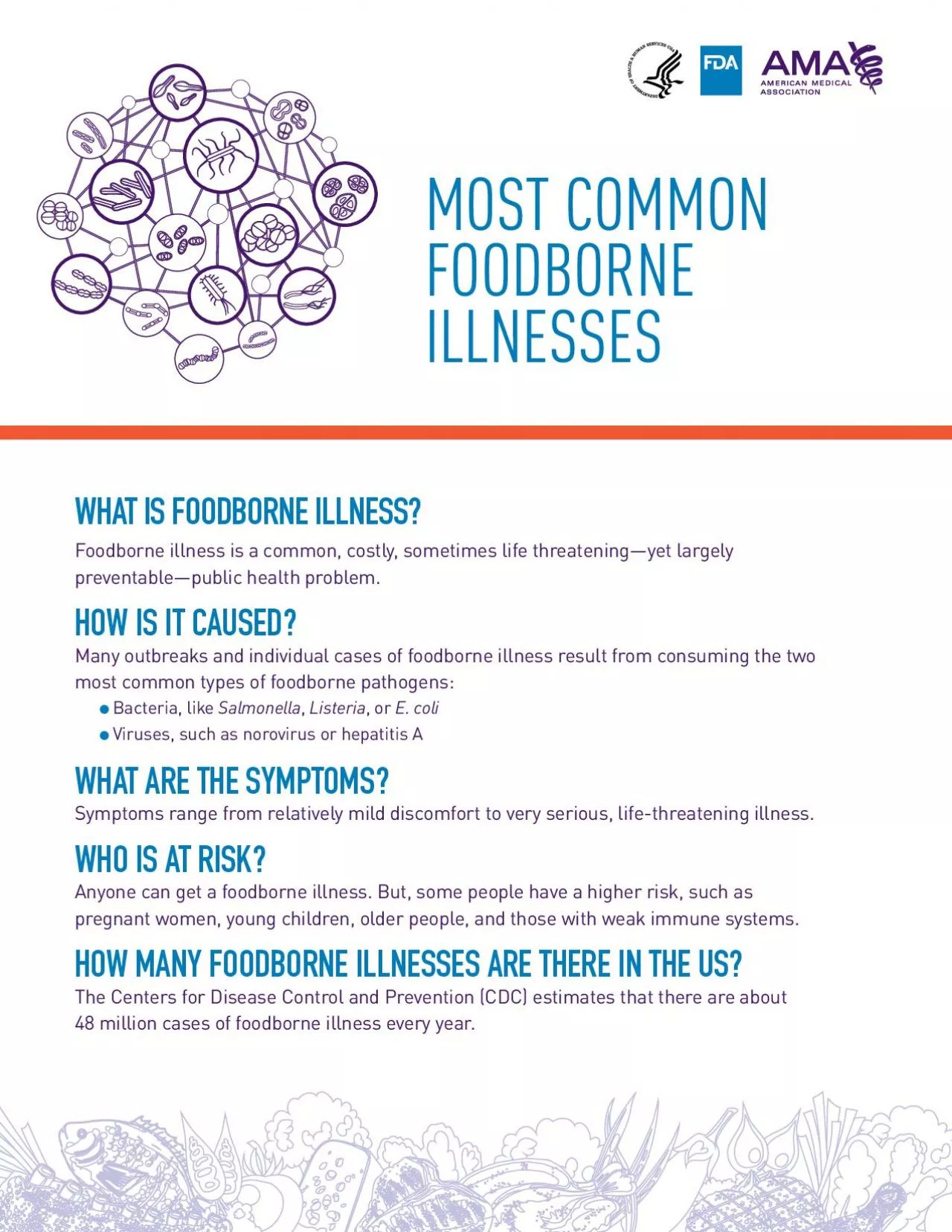

Bacteria like SalmonellaListeriaE coli Viruses such as norovirus or hepatitis AWHAT ARE THE SYMPTOMSSymptoms range from relatively mild discomfort to very serious lifethreatening illnessWHO IS ID: 949902
Download Pdf The PPT/PDF document "WHAT IS FOODBORNE ILLNESSFoodborne illne..." is the property of its rightful owner. Permission is granted to download and print the materials on this web site for personal, non-commercial use only, and to display it on your personal computer provided you do not modify the materials and that you retain all copyright notices contained in the materials. By downloading content from our website, you accept the terms of this agreement.
WHAT IS FOODBORNE ILLNESS?Foodborne illness is a common, costly, sometimes life threatening—yet largely preventable—public health problem.HOW IS IT CAUSED?Many outbreaks and individual cases of foodborne illness result from consuming the two most common types of foodborne pathogens: Bacteria, like SalmonellaListeriaE. coli Viruses, such as norovirus or hepatitis AWHAT ARE THE SYMPTOMS?Symptoms range from relatively mild discomfort to very serious, life-threatening illness.WHO IS AT RISK?Anyone can get a foodborne illness. But, some people have a higher risk, such as pregnant women, young children, older people, and those with weak immune systems.HOW MANY FOODBORNE ILLNESSES ARE THERE IN THE US?The Centers for Disease Control and Prevention (CDC) estimates that there are about 48 million cases of foodborne illness every year.MOST COMMON FOODBORNE 2 Common Foodborne Disease CausesEscherichia coli is a major bacteria species and can live in human intestines. Some E. coli species do not cause disease. But, there are other types of E. coli that can cause severe illness. E. coli can enter your body through contaminated food or water, and is often involved in major foodborne outbreaks around the world.Protect yourself and others—Avoid illness from E. coli by practicing safe food handling, cooking meats thoroughly and avoiding unpasteurized—raw—milk and unpasteurized juices such as fresh apple c
ider.NOROVIRUSIn the US, norovirus is the most common cause of illness from contaminated food or water—but food isn’t the only way people can get norovirus. It also spreads easily from person-to-person. Symptoms usually start within 1 or 2 days of eating the contaminated food, but may begin in as few as 12 hours. Projectile vomiting is often the first symptom, along with diarrhea and cramps. Headache, mild fever, and muscle aches may also occur.Protect yourself and others—To avoid norovirus, practice safe food handling and good handwashing.Salmonella causes two kinds of illness:(1) Salmonellosis—usually characterized by nausea, vomiting, diarrhea, cramps, and fever, with symptoms generally lasting a couple of days and tapering off within a week.Many kinds of food can become contaminated, from meats and eggs to fruits and vegetables, spices and nuts. Page 2 (2) Enteric fever—high fever, diarrhea or constipation, aches, headache, and drowsiness. Enteric fever includes typhoid fever and paratyphoid fever.The vast majority of enteric fever infections occur in travelers who were infected outside of the US.Up to 10% of people with enteric fever who don’t get treatment may die.Enteric fever usually is associated with sewage-contaminated drinking water.Protect yourself and others—Cooking foods thoroughly, good handwashing, keeping raw foods separated from cooked foods, and keeping food
s at correct temperatures are good ways to avoid salmonella. Get vaccinated against typhoid fever if you are traveling to an area of the world with typhoid fever.CAMPYLOBACTERCampylobacter is a species of bacteria that is one of the most common causes of foodborne illness in the US. Most cases of foodborne illness caused by Campylobacter are sporadic, and not part of outbreaks. Campylobacter can enter your body through contaminated water, unpasteurized milk or cheese, and raw or undercooked poultry (and sometimes other kinds of meats and seafood). If an individual is infected, gastrointestinal symptoms—nausea, vomiting, diarrhea (sometimes bloody), cramps—as well as a fever typically appear within 2 to 5 days and may last up to 10 days. In some cases, Campylobacter may spread to the bloodstream and cause a life-threatening infection.Protect yourself and othersTo avoid Campylobacter, cook meat (especially poultry) thoroughly, practice safe food handling and good handwashing, and avoid raw or unpasteurized milk and cheese. HEPATITIS AHepatitis A is an illness caused by the Hepatitis A virus. One way to become infected is by eating or drinking contaminated food or water. Contaminated water, shellfish, and salads are the foods most often linked to outbreaks, although other foods have also been involved. The illness is usually mild. It starts about 2 to 4 weeks after the contaminated food or water is consumed an
d resolves itself in 1 to 2 weeks. Page 3 TAKE ACTION LEARN MORE Visit the FDA website at www.fda.gov/educationresourcelibrary For more information on common foodborne illnesses, check out the U.S. Food and Drug Administration’s (FDA) Foodborne Illness-Causing Organisms in the US. Symptoms may include fever, low appetite, nausea, vomiting, diarrhea, muscle aches, and yellowing in the whites of the eyes and the skin.Protect yourself and others—Good handwashing is a good way to avoid Hepatitis A.Although foodborne Listeriosis is not common, it is one of the leading causes of death from foodborne illness. Listeria can cause two forms of disease in humans: (1) One can range from mild to intense symptoms of nausea, vomiting, aches, fever, and, sometimes, diarrhea, and usually resolves itself. (2) Invasive Listeriosis is a more deadly form that occurs when the infection invades beyond the gut to sites like the blood or brain. This can cause blood infection, meningitis—infection aroundthe brain—and other potentially fatal problems. In pregnant women, Listeria infection cancause miscarriage, stillbirth, preterm labor, and severe illness or death in the newborn.Protect yourself and others—Good handwashing, keeping your refrigerator clean and at 40 F, separating raw foods from cooked foods, and avoiding unpasteurized—raw—milk and cheese are good ways to stay away from Listeria Page